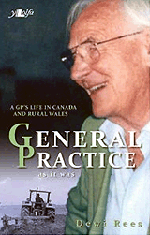 | General Practice as it Was: a GP's life in Canada and rural Wales YLolfa, Talybont, Wales |
Reading General Practice as it Was, conjured up an image of Dr Dewi Rees recounting stories about his remarkable career to a good friend. Presented as a series of short vignettes that span his life from 1956 until the present day, this book provides a glimpse into the diverse practice of a rural GP that is both interesting and accessible to readers of all backgrounds.
Beginning his career in the early days of the National Health Service (NHS) in Southern Wales, Dewi Rees' stories paint a picture of a different time in medical practice when GPs ran their surgeries from their houses, and attendance for home visits and at home births was the norm. Eager to develop his skills as a GP, and possessing an adventurous spirit, he took a position with the International Grenfell Association based in the isolated northern community of North West River, Labrador, Canada. Practicing medicine in Labrador in 1958 was certainly not for the faint of heart, and the challenging working conditions provided a seminal experience in Dr Rees' development as a GP. Following his experience in Labrador, Dewi Rees returned to Cardiff in Wales, to briefly practice psychiatry, one of his lifelong areas of interest, before returning to rural general practice in Llanidloes, Montgomeryshire, Wales. Spending 14 years in Llanidloes, Dr Rees recounts numerous interesting and notable cases, including: attending home births, responding to road traffic and tractor accidents, and the case of a pregnant woman struck by lightning.
Interested in research and publication throughout his career, Dewi Rees was awarded his MD for his thesis 'Hallucinatory Reactions to Bereavement', and went on to publish in the areas of rural accidents, bereavement, the distress of dying, the health of motorists, postnatal depression, the role of hospices in terminal care, and the use of opioid drugs in palliative medicine. In the mid-1970s, he also worked with the Civil Service Department in London as part of the research team for the well-known 'Whitehall 2' study of the health of 10 000 British civil servants.
The final 10 years of Dr Rees' career were spent as the medical director of St Mary's Hospice in Birmingham, which allowed him to further develop his expertise in palliative care and apply his clinical skills to the care of the dying. This role also provided Dr Rees an opportunity to share his wealth of knowledge and experience with the medical students and physicians who came in contact with this institution.
This book was an enjoyable read, and provides a wonderful window into the life of a dedicated physician who savored the experience of rural practice in Wales and Canada. He followed his passions throughout his career, while always being open to learning and new experiences. In the words of Dr Dewi Rees, he has been 'a fortunate man'.
Peter Kellett, MN
Faculty of Health Sciences
University of Lethbridge
Lethbridge, Alberta, Canada
